Six years is about par for the course for development of a new vehicle and so it has proved with the new Ineos Grenadier. It would be unfair, however, to compare Ineos, the petrochemicals giant owned by Sir Jim Ratcliffe, with smoke-stack car makers, because it really isn’t like them.
To recap, the Grenadier is a rather unusual thing in this day and age: a new 4×4 that has the proportions of a hay barn and the rugged construction of a farmer’s favourite tractor. It is named after the pub where it was conceived after Sir Jim failed to secure the rights to remanufacture the old Defender model which Land Rover stopped building in 2016.

Huddled in that Belgravia boozer, a tiny former officers’ mess (which Ratcliffe now owns) the basics of the Grenadier were sketched out on a beer mat – aren’t they always? Mark Tennant, Ineos Automotive’s amiable commercial director, shows me that beer-mat triangle device. At the top is design, bottom left durability and reliability, and bottom right off-road capability. There is no sign of the modern marketing jargon of ‘paradigm shifts’, ‘lighthouse projects’ and ‘customer experience’, or for that matter, monocoque structures and independent suspension. No, the whole thing was conceived to be as simple, straight-forward and satisfying as a pint of bitter, although Ratcliffe apparently favours a gin and tonic.
Reality, however, proved slightly more complex. First off, Ineos Automotive looked at producing the Grenadier in Wales in Bridgend close to Ford’s engine plant, which closed for good in September 2020 with the loss of 1,000 jobs. It had looked at the Mercedes-Benz plant Smart plant in Hambach in Lorraine in Eastern France, but at first sight that didn’t look like a good option. Then Ratcliffe received a telephone call from Ola Källenius, Mercedes boss asking him to think again. What hadn’t been exactly clear first time around was that the plant had been fitted out with a new production line and paint shop to make the Mercedes-Benz EQB SUV, which was now going to be built in Hungary. So Hambach had a 1,300-strong Mercedes-trained workforce, a warehouse full of body robots still in their plastic wrapping, rail links with suppliers including BMW for the engines and most likely, as the deadline for closure fast approached, a big discount. So, Hambach it was; good news for the workers, Mercedes, the French government and Ineos, but not quite so much for Wales.
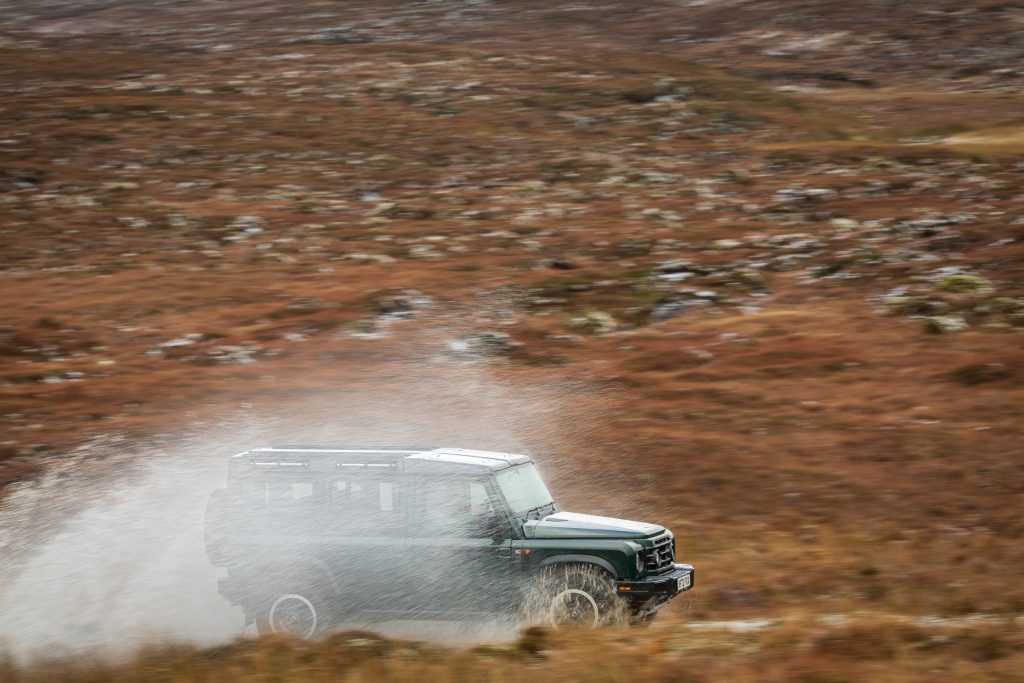
But make no mistake, this is a serious effort. The design from Toby Ecuyer, a former yacht designer, has been engineered by Magna, the Canadian/Austrian specialists which built the first Mercedes-Benz G-wagen. The separate chassis is built by German specialists Gestamp, and the front and rear beam axles are designed and built by Carraro in Italy. In the last couple of years Ineos Automotive has had to build not just a production line, but also a production system and train a workforce. They’ve set up a brand-new sales and service network to sell and look after these vehicles round the world as well as writing service and parts manuals and holding off eager customers and the press.
Covid took a big bite out of that preparation, with a shortage of electronic components such as semi-conductors holding up the launch which should have taken place last autumn as well as the first deliveries of cars to customers. But now we’re here, in Inverness, travelling down a route that takes in the spine of Scotland and England and some of the toughest terrain the country and weather can throw at it.
It’s snowing (of course it is) and in the flood lights with a light dusting of snow over the clamshell bonnets, flat windscreens, exterior door handles and the heavily waisted side panels, the array of Grenadiers looks like a car park full of Defenders, maybe with a bit of Austin Gipsy thrown in.
Sizing up the Grenadier
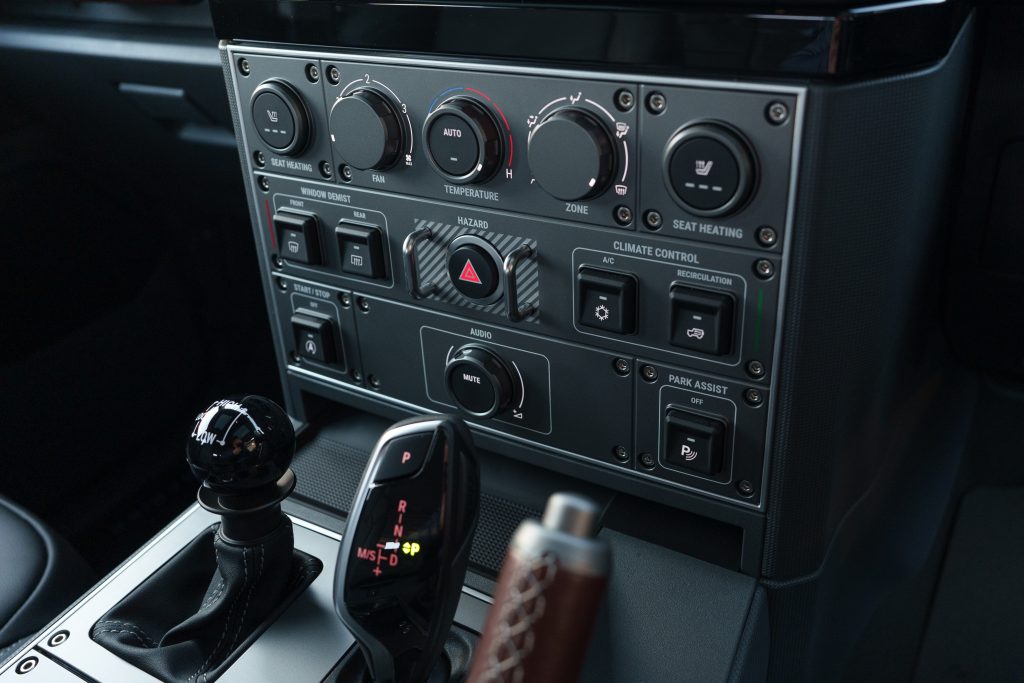
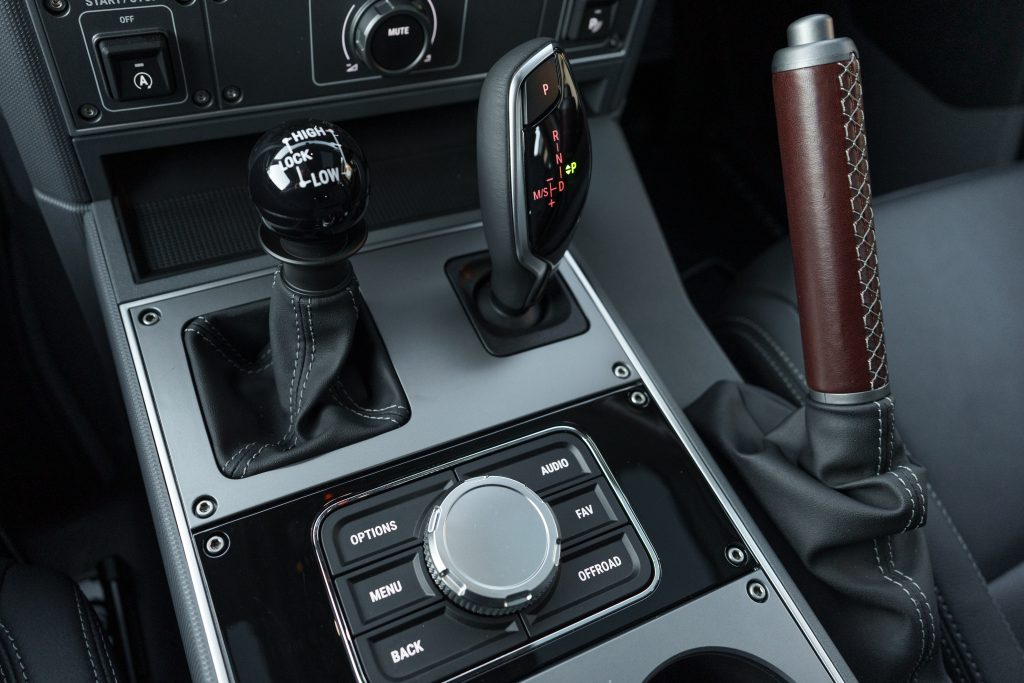
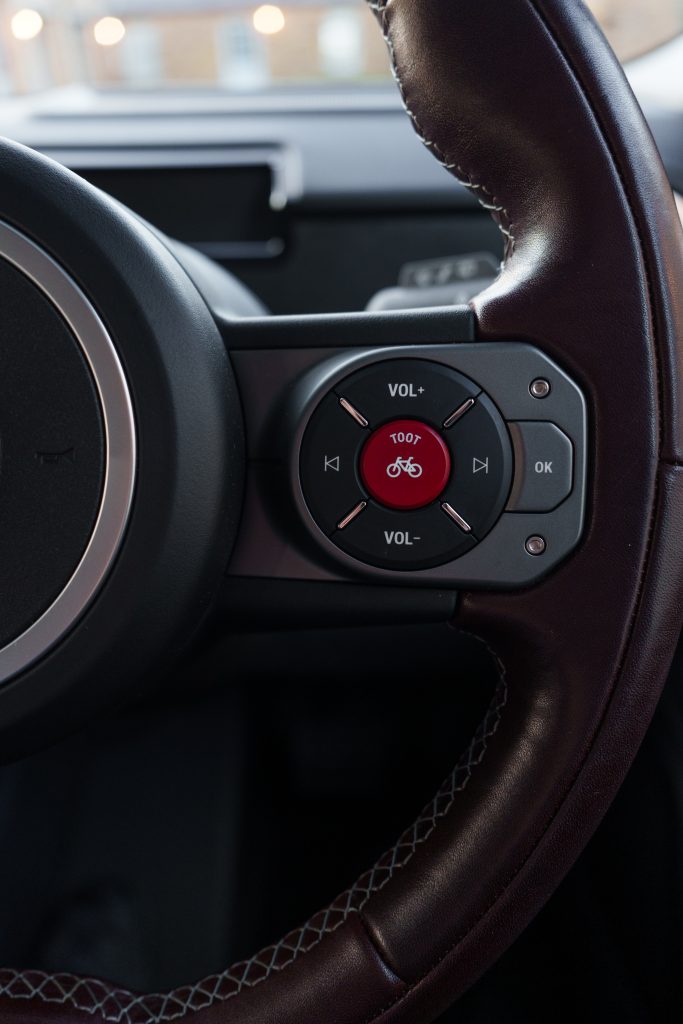
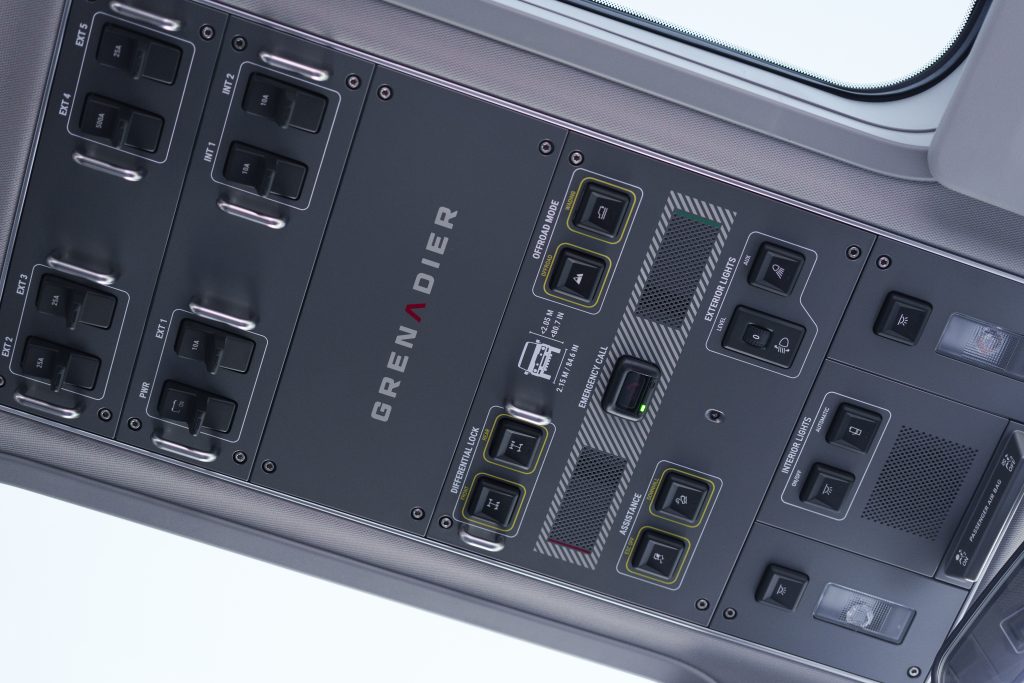
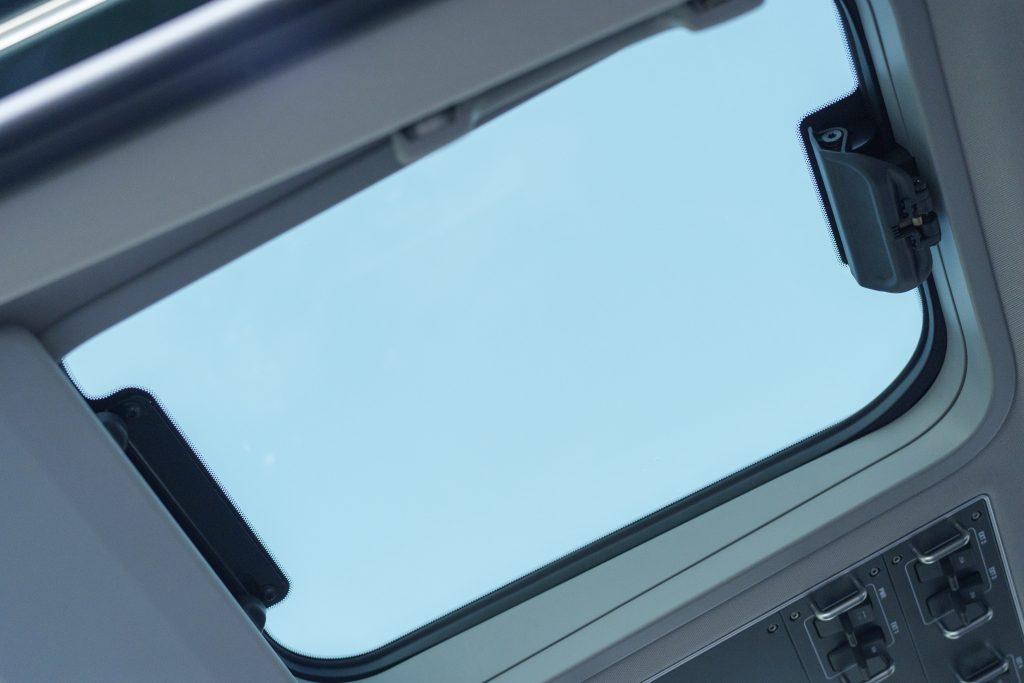
Grenadier is 4,896mm long, 2,146mm wide with the mirrors out (1,930mm without them), 2,036mm high and runs on a 2,922mm wheelbase and weighs between 2,644kg and 2,740kg when fully specced. There’s a crew cab pickup and chassis cab slated for deliveries later this year and eventually a smaller battery-electric SUV based on Magna’s skateboard structure, but for the moment, this five-door 4×4, five-seat version is it and if you ordered today, you’d get your Grenadier at the beginning of next winter.
It’s based on a massive, ladder-frame separate chassis, all Metal Inert Gas (MIG) welded and flitch-plated, with side members up to six inches deep. Rising-rate coil springs and telescopic dampers keep the front and rear solid axles in check and there’s a steering box rather than rack and pinion. An all-BMW engine choice consists of a three-litre, straight-six available as a twin-turbo 245bhp/406lb ft diesel, or 281bhp and 332lb ft single-turbo petrol, with a ZF eight-speed automatic gearbox. Top speed for both is 99mph, with 0-62mph in 8.6sec for the petrol and 9.9sec for the diesel. WLTP fuel consumption is 18.5 to 21.4mpg for the petrol, 23.9 to 27.4mpg for the diesel.
There’s permanent four-wheel drive, with a two-speed transfer case to give a set of crawler gears, with a standard locking centre differential and optional locking differentials in the front and rear; these come in the £1,765 Rough Pack, which includes BF Goodrich KO2 off-road tyres.
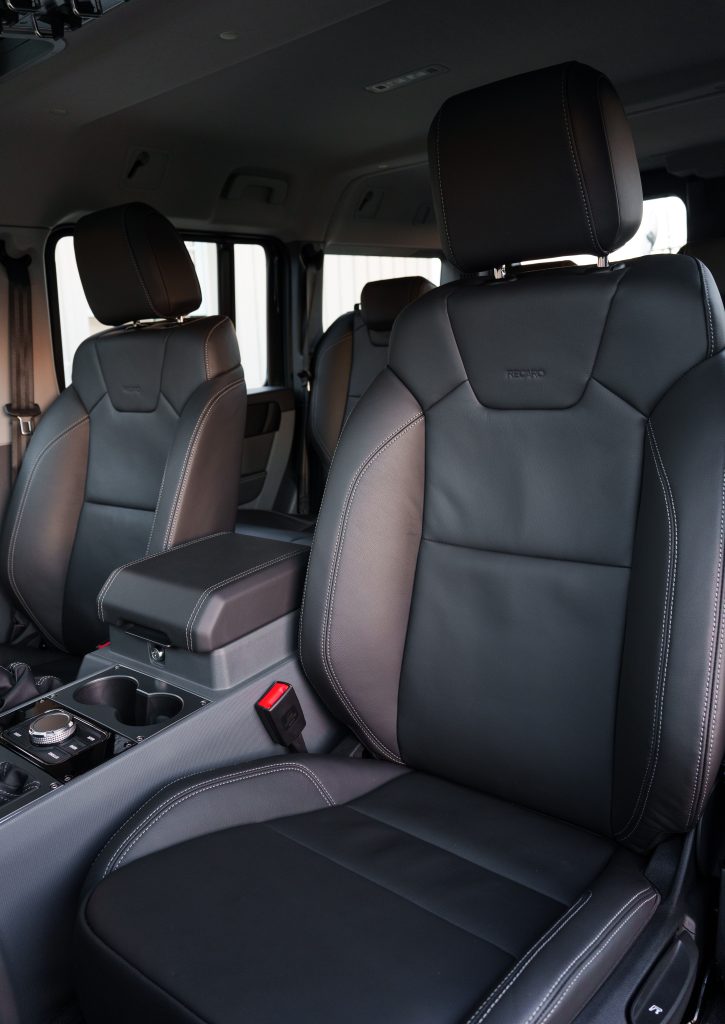
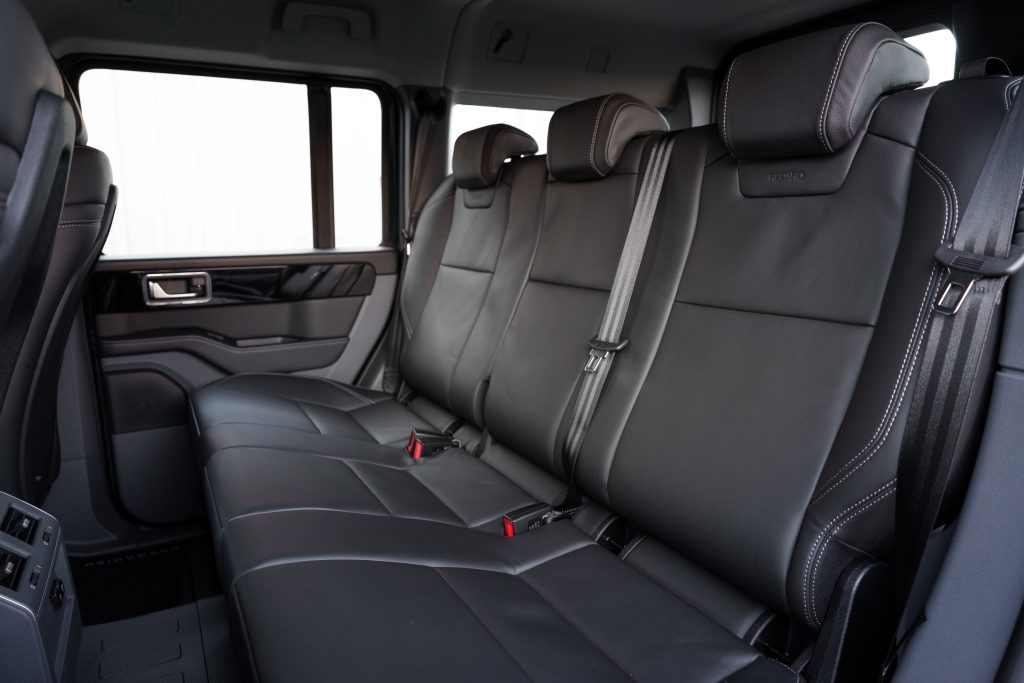
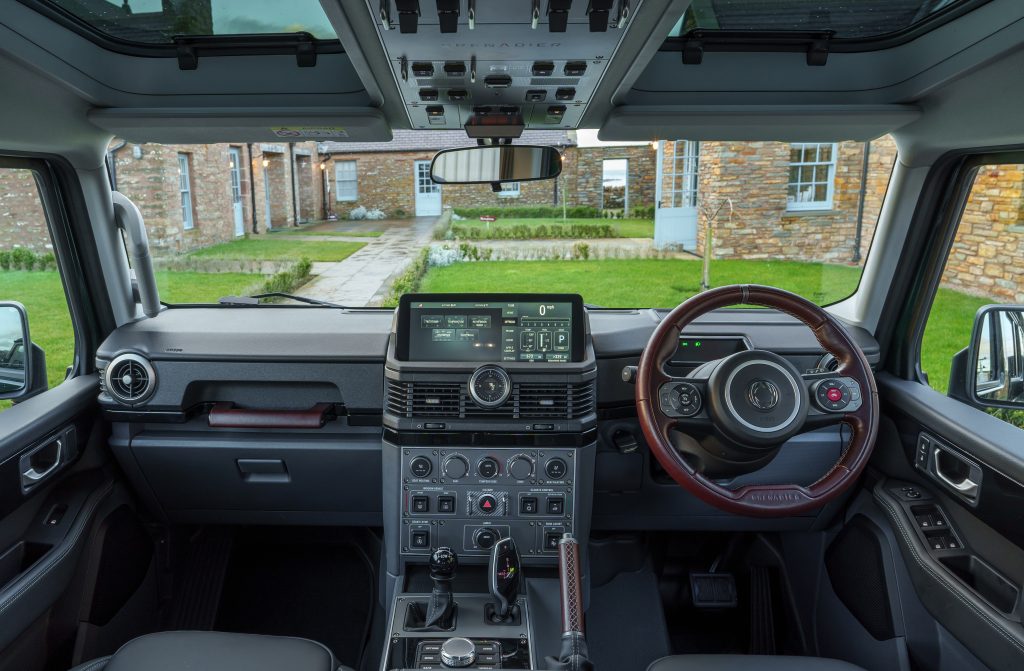
There’s also a £1,435 Smooth Pack, which contains a rear-view camera, front parking assistance, powered and heated door mirrors, heated windscreen washers, a lockable centre storage box, puddle lamps, ambient door lighting and auxiliary charging points.
Wheel choice is between 17 and 18 inches with Bridgestone all-terrain, all-season tyres, or the aforementioned optional off-road covers which were fitted to our test vehicles. The vehicle is also festooned with brackets and sockets for which Ineos will sell you a host of extras, but which it also hopes will be taken up by outside suppliers for their extra kit.
This is the sort of spec, with a separate frame and solid axles with low-range transfer boxes and lockable differentials, which normally underpins a serious cadre of hard-working utility vehicles, like the Toyota Land Cruiser or an Isuzu D-Max pickup. For the dedicated off-roader, this configuration gives theoretical better axle articulation, ground clearance and is tougher than independently-sprung monocoques, although some of those drawbacks can be assuaged with air suspension and compact suspension design, but not all of them. Grenadier’s ground clearance is 264mm, wading depth is 800mm, the approach, breakover and departure angles are, respectively, 35.5 degrees, 28.2 degrees and 36.1 degrees and it’ll tow up to 3.5 tonnes and winch up to 5.5 tonnes. For the record, Land Rover’s 110 Defender model has a ground clearance of 291mm, a wading depth of 900mm, approach angle of 38 degrees, breakover angle of 28deg, departure angle of 40deg and will tow 3.5 tonnes. On paper then, the Land Rover is more capable, but off-roading is a highly inexact science depending much on the tyres, the drivetrain, the driver and the day, and besides, you can’t put a value on toughness.
But the fact that Grenadier is here at all is something of an achievement. What Sir James Dyson, the hoover knight, failed to do when he quit his plan to build a battery car, Jim Ratcliffe the chemicals knight is carrying off, or is he?
Ineos Grenadier pricing
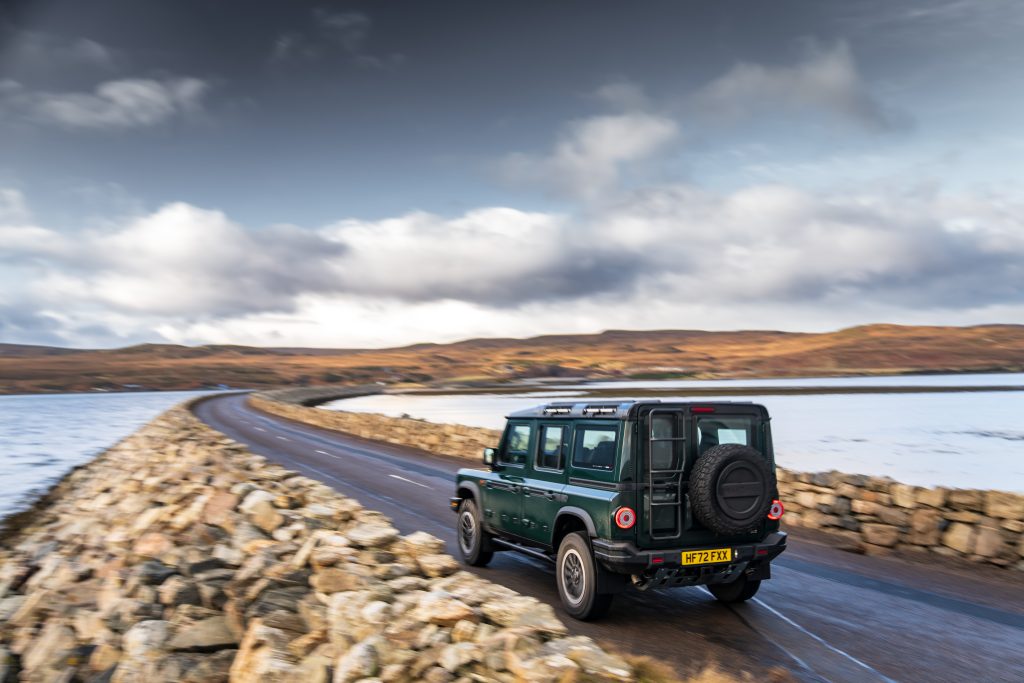
For the moment there’s just one version in two-seat Utility trim priced from £55,000, or a five-seat station wagon priced from £58,000, with a couple of better-equipped Belstaff-inspired special editions of the latter, the Fieldmaster and the Trialmaster both priced from £69,000 – not at all coincidentally, Sir Jim owns Belstaff. Our Fieldmaster test vehicle, with a fair few bells and whistles retailed at £73,000.
Clamber up into the cab and from a lofty perch, you get decent views out to the front and sides, but not so much to the rear. Clanky mechanical seat controls move the seat back and forward, though probably not rearward enough for the tallest drivers. The dash is filled with huge push buttons, there’s an aircraft style overhead switch panel pre-wired for emergency lighting and light bars, and overall there’s a distinct impression this cabin is different to anything else out there.
The driving position is reasonably comfortable and certainly better than the previous Defender, though the pedals are offset from the steering. Rear seats are comfortable and there’s just enough room for three six footers to sit across the bench with head room but not much knee room to spare. The rear back splits 60/40 per cent and folds onto the seat benches, but the load bed is uneven and there’s no ski hatch so you’ll have to put them on the roof or on one side of the cabin. Luggage capacity is 1,152 litres with the rear seats up, 2,035 litres with them down. Equivalent figures for the Defender are 499/1,946 litres. Our test car got seat warmers as standard but on everything else they’re an additional £320, which seems a bit of a swizz, and leather upholstery can be had for just under £1,800.
There’s a slightly strange dichotomy between the tough plastic fascia and rubber floor mats on the one hand, and the touch screens and digital displays on the other, but apparently BMW’s engine systems have to be used in their entirety including the screens, or the six-pot simply won’t start. Those plastics aren’t built for comfort, though and knock knees and elbows during a day’s off roading. Nor are they particularly easy on the eye for a £73,000 car. Some will welcome this stripped-to-the-bone look, others will prefer the cabins of some of the opposition. Our diesel Fieldmaster had the £655 option of saddle leather covering for the steering wheel and one of the three passenger grab handles, which was really nice, but what about the other two handles? Moreover, why does the front-seat passenger get a grab handle (on the A-pillar) to help access the seat, but no one else?
There’s also a distinct lack of storage space in the Grenadier and those spaces that are there haven’t been well thought out. The door pockets are unlined and small (apparently, they had been bigger but couldn’t be accessed with the door closed). There’s a shallow depression on the driver-side dash top, which could have held a mobile telephone, but isn’t deep enough and has a slippery lining. The top door pocket/handle might have been useful as an oddment space, but it’s too small and also unlined, and the phone slot in front of the gear levers is difficult to get to.
Glitches with the Grenadier
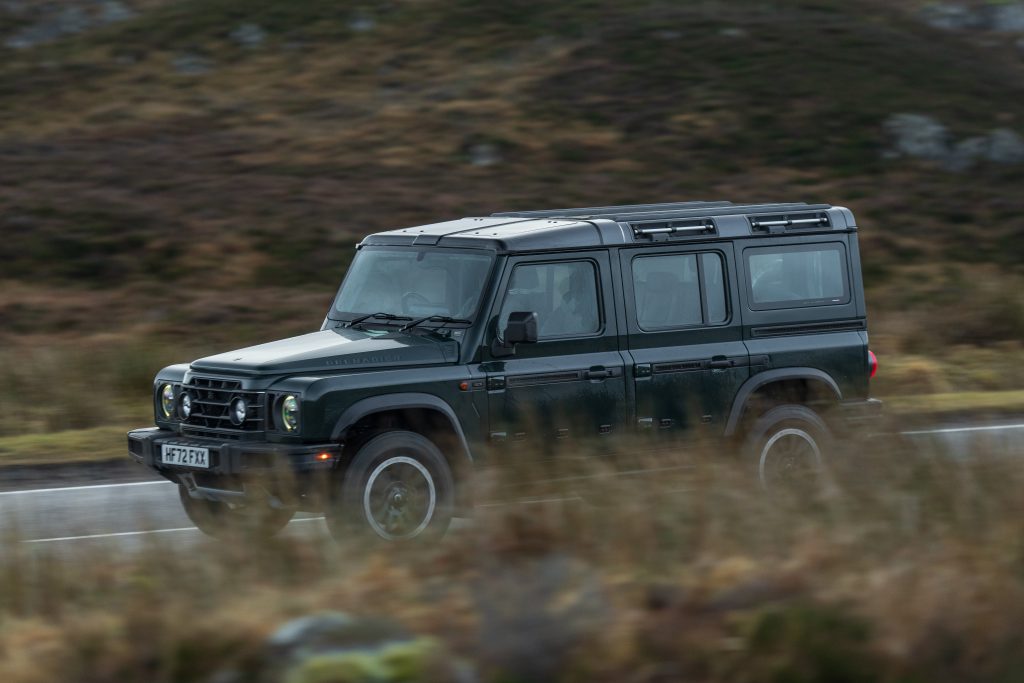
My first-ever road test editor on Commercial Motor magazine used to growl that you do the test on the day and mention everything, “because if they can’t get it right for you, then God help their customers”. So in the spirit of Bill Brock, here goes: the passenger-side door mirror failed to defrost itself; the doors on these cars all required very different efforts to shut; there was an annoying whine from the front differential; the centre differential/transfer box didn’t always engage; the differential locks also didn’t always disengage and even if they did eventually disengage they failed to tell the vehicle electrics that they had done so which blocked off other functions; the transferable software for the Pathfinder sat nav failed to transfer; and the windscreen wipers which left the top half of the windscreen dirty and the washers didn’t squirt enough screen wash and the meagre amount of fluid they did squirt was aimed at the wrong place; oh and the non-existent aerodynamics meant the side screen quickly became opaque with road dirt so you couldn’t see the door mirrors.
Yes, these are all fixable niggles, and yes, Ineos provides a five-year unlimited mileage warranty which is competitive, but they don’t augur well for a brand-new car which is currently being delivered to customers.
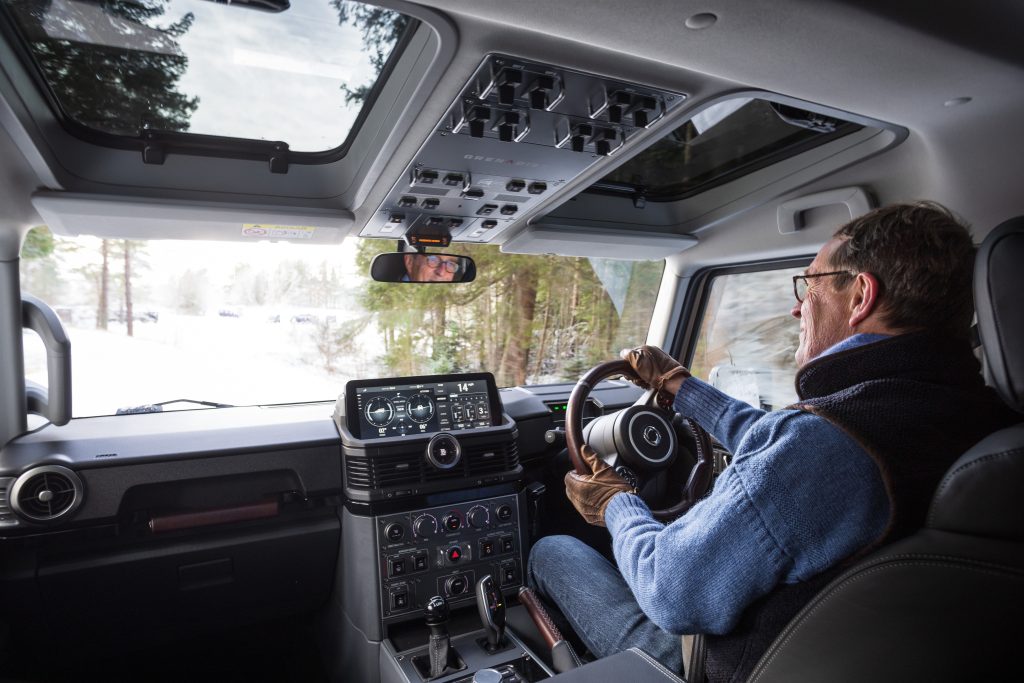
And Grenadier, it has to be admitted, is idiosyncratic. Those asymmetrically-split rear doors (like those on the old Isuzu Trooper) give you a bisected and obstructed view out of the back in the rear-view mirror, with only one part having a screen wiper. The overhead switches might seem a good idea, but they are very hard to identify in hurry. The stubby lever which engages the transfer box and the centre differential lock is really hard to move and didn’t always disengage. Oh, and the optional front winch (£3,345) lurks behind the front bumper behind a removable plastic panel with the registration plate on it, which is fine and dandy if you do all your winch recovery off the King’s Highway.
You start up with a real ignition key and in both the petrol and diesel versions, the big BMW six growls into life and stays growling which seems an indication of at least harder engine mounts than when it appears in a BMW model. There’s a big manual hand brake and a familiar gearlever for the ZF eight speed and the throttle control is accurate as you pull away. With the snow gates closed on high passes we started the day on the A9 where the windscreen stayed dirty and the engine settled to a high-geared cruise. Heavily cleated BF Goodrich tyres set up a noisy uneven fizz in the cabin.
Diesel or petrol, the driving experience is broadly similar, the petrol unit has less low-down torque and more refinement, but worst fuel consumption. Stand on it and the ‘box changes down a couple of ratios and the revs soar. It’s not fast exactly, but brisk considering the 2.8-tonne weight and we saw 19.5mpg from the diesel on a mixed route of rough terrain and Tarmac.
The ride’s good, though, with those progressive rate coils giving a soft response to bumps and undulations. The handling, however, particularly on these tyres isn’t up to much. As we noted on the prototype drive, the steering box is very low geared with almost no self-centring and quite a bit of free play – apparently the slow gearing was a German autobahn requirement, though it’s difficult to see why. In a straight line, the Grenadier wanders around on the road, with vague and uncertain turn in to corners. You often have to correct it several times and on dark, wet and winding roads later in the day, it’s neither confidence inspiring or much fun.
On the plus side, the brakes (twin-piston ventilated discs at the front, with single-piston solid discs at the rear), are powerful and feel progressive. On this evidence, the new Land Rover Defender (reviewed here) would eat it alive on the road, but there is an intermediate tyre option which should improve things, though these weren’t available to drive.
Into the rough stuff
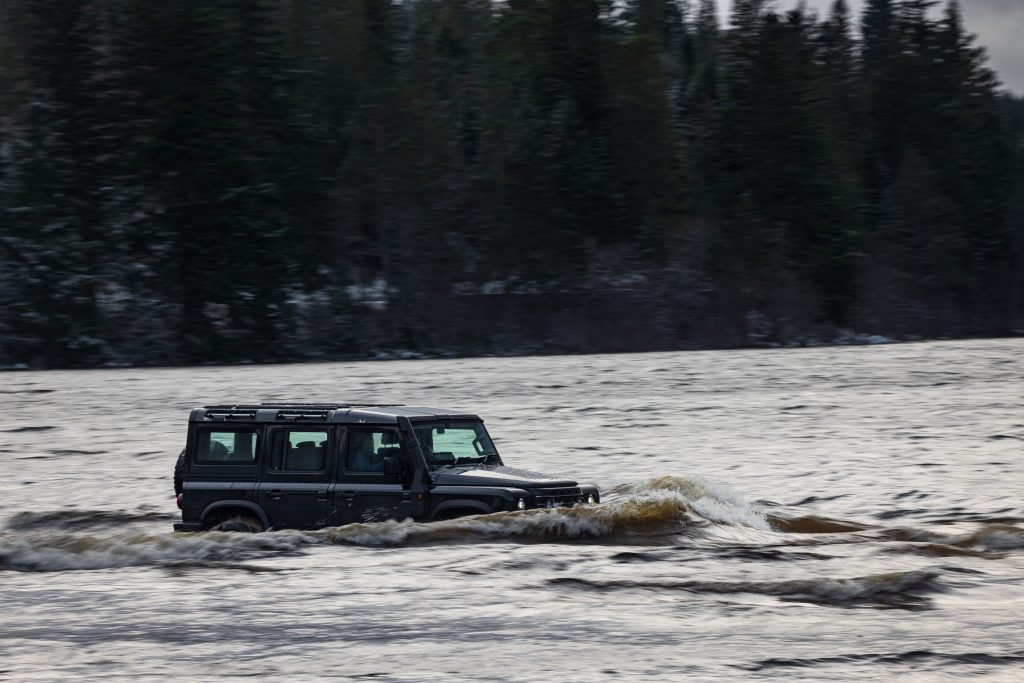
Turn onto the quite lovely Adverikie Estate, in the Scottish Highlands, and the Grenadier felt a lot more at home; stable, its wheels dug into the light snowy surface and the car felt never less than a stout place to be. That initially soft suspension response keeps things calm, but not tippy as the spring rates and damping soon catch up with the body roll. First-rate wheel articulation keeps the tyres in contact through the most cross axling terrain and those cleated tyres grip an icy rock surface like a lion’s claws on its prey. Clearly the diesel is the better lugger in these circumstances, but the petrol isn’t bad and the accurate throttle control means you have no need to take a run up; both engines will tackle most things at idle speed.
The way the Grenadier walks on a rough snowy track is quite lovely, and with low ratios and three differential locks, you can ascend most slopes at the speed of the wheel with most grip and the hill descent control is excellent. Trouble is, the diff locks weren’t always working…
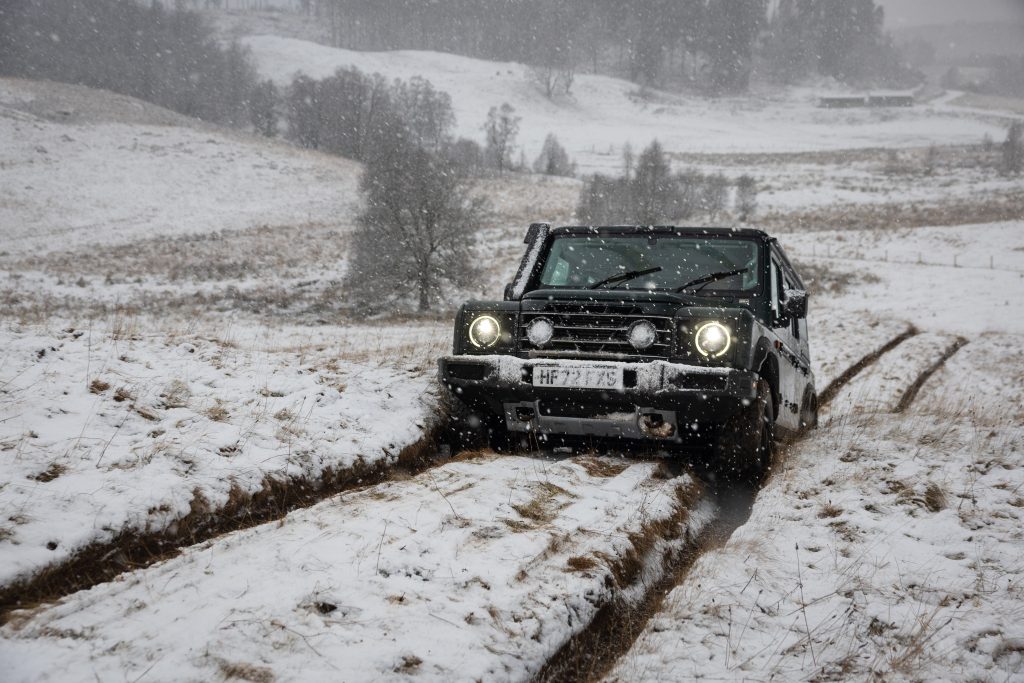
Would an original Defender traverse this stuff as well? Probably not, though it would be darn close. Equally close, too, with a new Defender in which I’ve tackled some very serious terrain and mud and ruts you couldn’t even stand up in.
For a company that has never built a car before, this is an impressive debut and if the majority of your work is in off-road, tough conditions, then Grenadier is competent and probably worth a look, but then so is the Isuzu D-Max, Toyota Land Cruiser, Jeep Wrangler and dare we say it, Land Rover’s Defender.
And while not one of the ten test Grenadiers stopped working, there were too many faults and daft design decisions to pass muster; if any of the competition had turned up with this many howlers they’d have been pilloried.
It’s nice to think there’s a market for roughy toughy vehicles like this, but the truth is more nuanced and Grenadier, like its rivals, needs to appeal to the all-hat-and-no-cattle-brigade as well as the beady-eyed farmers, strait-laced military procurement boards, penny-pinching utilities and so on. And those business customers are rightly demanding.
From beer-mat to vehicle, this is a great story, but there’s a hell of a lot more work to do to make Grenadier credible. At the moment, it’s far too like the old Defender model for the good, but most of all, the bad.
2023 Ineos Grenadier Fieldmaster specifications
On sale: now
Price: from £55,000 as tested £73,000
Engine: 3-litre, six-cylinder turbocharged diesel or petrol
Power: 245bhp diesel; 281bhp petrol
Torque: 406lb ft diesel; 332lb ft petrol
Gearbox: 8-speed torque converter automatic ZF gearbox, centre transfer box and lockable centre differential, four-wheel drive
Fuel economy: petrol 18.5 to 21.4mpg; diesel 23.9 to 27.4mpg; 19.5mpg in the diesel on test
CO2 emissions: 299-346g/km petrol, 268-308g/km diesel
0-60mph: diesel 9.9 seconds; petrol 8.6 seconds
Top speed: 99mph
VED: £2,365 (petrol and diesel) first year, then £165, with £355 a year luxury car tax supplement for first five normal years
Warranty: 5 years/unlimited mileage
Check out the Hagerty Media homepage for daily news, features, interviews and buying guides, or better still, bookmark it.


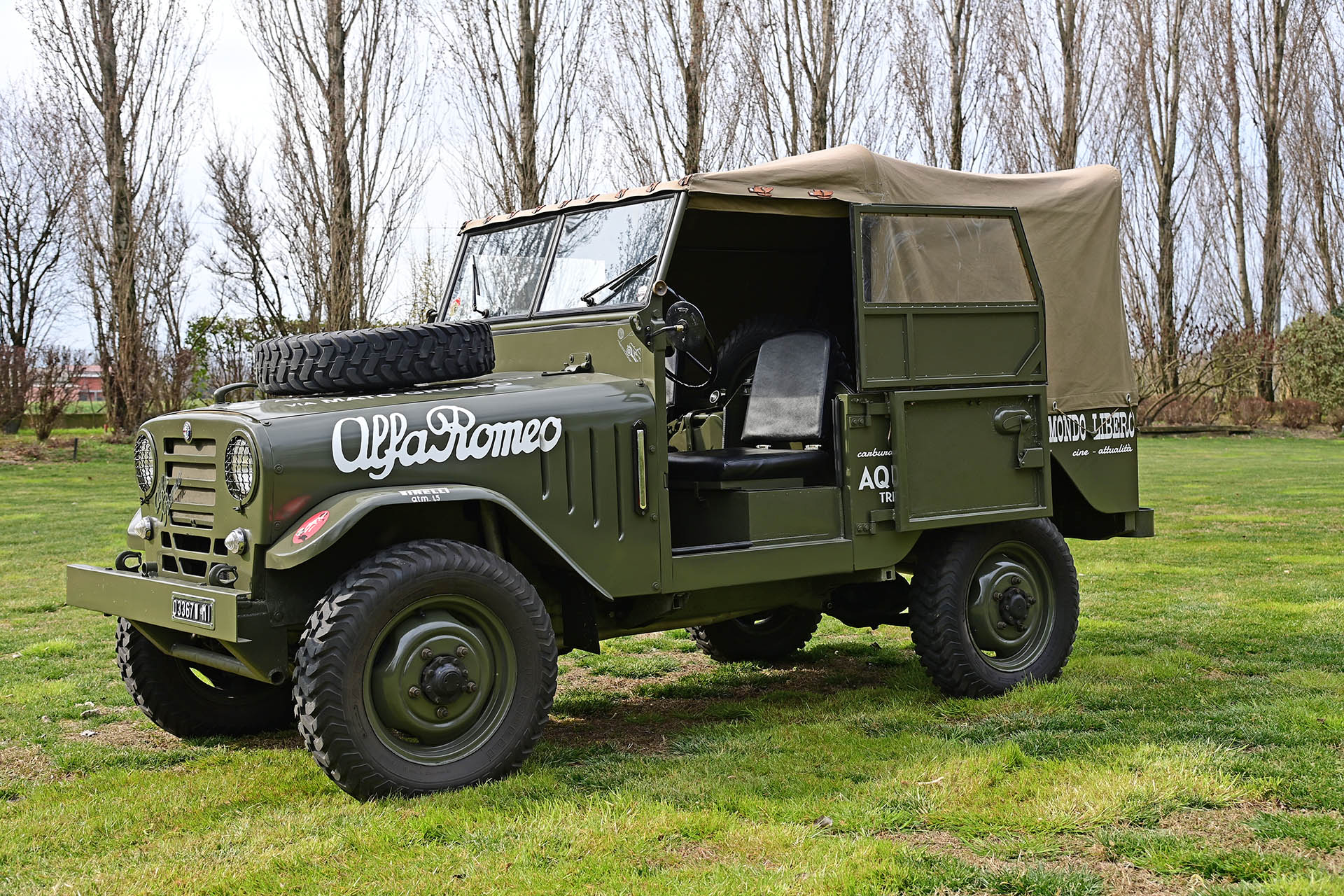








<>
Don’t let any Scotsmen hear you talking of Inverness being in “the England”!
[I’m eagerly awaiting delivery of my Grenadier, depite being a long-term ‘Green Oval’ enthusiast… but JLR just don’t build anything I want to buy anymore.]
Dear Mr Aldous, thanks for the post and with a Scottish grandmother I would try not to make such an error (I’m still fizzing with joy at the Six Nations result on Saturday). Good luck with your Grenadier and hope you like it.
All the best, Andrew
I read it through then scrolled back to the top to see what talented journalist had written this masterpiece: Andrew, I had no idea that you had CV and off-road expertise. The car may be lacking, but the journalism is absolutely first rate, thanks.
They all expect it to be like an SUV (of which the new Defender is), were in reality it’s always been designed to be utilitarian (tough and practical)
Would love to see the design on that beermat. It must have been a very accurate rendering of the old Defender, because that’s exactly what it looks like. “… it’s far too like the old Defender model for the good, but most of all, the bad”. Indeed. The old model was dropped because its sales were poor. Does the world really need an identikit rehash of it? I’m doubtful, but of course only time will tell.
Dear Richard, Many thanks. Yes, my writing career started at The Commercial Motor! And yes Trevor, I think you are right, there’s a big gap between expectation and reality here, but this car should have been better finished and presented.
All the best,
Andrew
Apart from James and Graeme comments, both Andrew’s article and the other comments fail to grasp the joy of the Grenadier in that it is not a modern SUV. Having run overland tours in North Africa and Oman, the last thing I needed was a style conscious electronic-obsessed soft off-roader. The Grenadier – unlike the new Defender – seems to be just the ticket for the real adventurer. A brave project and I really hope it succeeds
Except that it certainly is a style conscious electronic-obsessed vehicle. It can be nothing else in this safety and emission conscious age. Electronics will not be de-invented and neither the BMW engine nor the ZF automatic will work without a ridiculous amount of electronics and ECU’s. Neither will the safety systems, the auxiliary battery and control panel, the dashboard or even the lights. All linked by CAN-bus wiring for ‘simplicity’, just like its modern rivals.
I own a Grenadier. The absence of a grab handle on the driver’s side is because the vehicle was designed principally for left hand drive. This is confirmed by the positioning of the bonnet release, left hand side. Also, there is a lump where your left foot rests, apparently due to exhaust routing. A left hand drive version would not have this problem as there is no lump and a comfortable place to rest your foot. Finally, the ignition key entry needs illumination like the HiLuz.
I have to say it’s rather interesting for there to be so much negative critiquing of this vehicle in certain categories.
Certainly, any electronic gremlins or faults that leave you stranded are real put offs and must be fixed.
But has anyone driven in back-to-back with an old defender?
Build quality, structural rigidity, frame and component rust, hard interior plastics, lack of storage, interior roominess….?
Looks like we have some rather forgetful nostalgia…
If a Grenadier is a 7/10, surely an old Defender is a 3/10.
After my first Grenadier drive (even at 70mph), I have to commend the incredible design and build effort here.
I am a buyer!
Reckon many of those who criticise the Grenadier are much too anaesthetized by the modern SUV.
I have just traded in a new Devender for a Grenadier….. and love it!
Why. Because I wanted a tough, rugged and no nonsense vehicle and I love it!!
The Defender was great and an absolute delight to drive, plus excellent off the road. But it was too effite and so much like an ever so smooth Range Rover with a flat back, designed to vaugly.imitate the old Defender.
I wanted a proper no nonsense rugged vehicle and the Grenadier exactly fits this bill. Furthermore it is a statement in its own right. Different than anything else on the road.
Yes it has niggles, but must vehicles have them. The biggest seems to be the so called ball joint steering which is said to be vauge. Takes a bit of getting used to, but once used to it’s great, no problem whatsoever.
Some of the criticisms just over the top. One guy said pity the the transfer knob as plastic should have been made of metal!!
A lot of unfair niggles by people too used to modern soft vehicles.
Notice, most new Defenders seem to be driven these days by women doing the shopping.